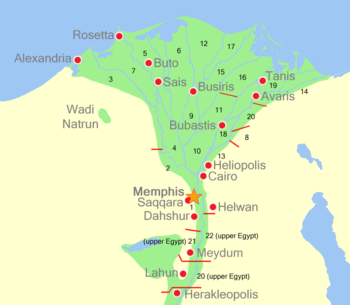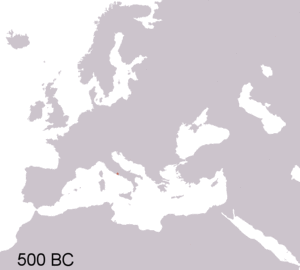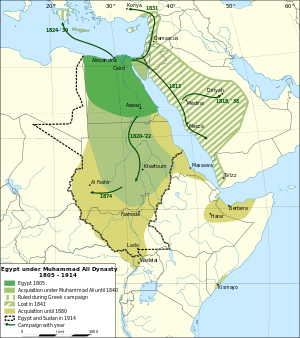List of conflicts in Egypt

Map showing the present-day location of the Arab Republic of Egypt within North Africa.
This is a list of conflicts in Egypt arranged chronologically from ancient to modern times. This list includes nation-wide and international wars, including: wars of independence, liberation wars, colonial wars, undeclared wars, proxy wars, territorial disputes, and world wars. Also listed might be any battle that occurred within the territory of what is today known as the, "Arab Republic of Egypt" but was itself only part of a operation of a campaign of a theater of a war. There may also be periods of violent civil unrest listed, such as: riots, shootouts, spree killings, massacres, terrorist attacks, and civil wars. The list might also contain episodes of: human sacrifice, mass suicide, massacres, and genocides.
Prehistoric times
Prehistoric Egypt
- c. 12376 BCE[1] Battle at Cemetery 117[2]
Ancient times
Early Dynastic Period of Egypt

Map showing Lower Egypt with historical nome divisions numbered (Lower Egypt is north of Cairo, downriver along the Nile River's drainage divide.) Memphis, the capital city of the nome Aneb-Hetch in Lower Egypt is labeled here with a star. c. 3100 BCE.

Map showing Upper Egypt with historical nome divisions numbered (Upper Egypt is south of Cairo, upriver along the Nile River's drainage divide all the way up to the first cataract after Aswan.) Thebes, the capital city of the nome Waset in Upper Egypt is labeled here with a star. c. 3100 BCE.
- c. 3100 BCE Unification of Upper and Lower Egypt[3]
- c. 3050 BCE Hor-Aha, the second pharaoh of Egypt, led a campaign against the Nubians.[4]
- c. 2890 BCE After the death of Qa'a, the last pharaoh of the First Dynasty of Egypt, a short war may have occurred for the throne of Egypt, ending with the accession of Hotepsekhemwy.[5][6][7][8]
- c. 2690 BCE Khasekhemwy reunited Upper Egypt and Lower Egypt after a short period of political fragmentation.[9][10]
Old Kingdom of Egypt
- c. 2670 BCE Djoser, the first pharaoh of the Third Dynasty of Egypt, dispatched several military expeditions to the Sinai Peninsula, during which the local inhabitants were subdued
First Intermediate Period of Egypt
- c. 2150 BCE The 4.2 kiloyear event triggered famines, social disorder, and fragmentation.[11]
- c. 2140 BCE During the reign of the pharaoh Neferkare III, the nomarch of Hieraconopolis Ankhtifi, led a coalition of his nome and Edfu against Thebes.
- c. 2120 BCE Mentuhotep I and Sehertawy Intef I, independent rulers at Thebes in the early eleventh dynasty of Egypt, had soldiers fighting the Coptite nomarch Tjauti, and the subsequent defeat of Tjauti ultimately put Koptos, Dendera and the three nomes of Hierakonpolis under Theban control, expanding the Theban kingdom 250 km northward with a border near Abydos.
- c. 2075 BCE The pharaoh Akhtoy Nebkaure sacked Thinis
Middle Kingdom of Egypt
- c. 2061 BCE — c. 2010 BCE Campaigns of Mentuhotep II
- c. 1705 BCE — c. 1648 BCE After the death of the sixth pharaoh of the Fourteenth Dynasty of Egypt Nehesy Aasehre, the 14th dynasty continued to rule in the Nile River Delta region of Lower Egypt with a number of ephemeral or short-lived rulers until 1650 BCE when the Hyksos Fifteenth Dynasty of Egypt conquered the Delta.[12]
Second Intermediate Period of Egypt
- c. 1705 BCE — c. 1648 BCE After the death of the sixth pharaoh of the Fourteenth Dynasty of Egypt Nehesy Aasehre, the 14th dynasty continued to rule in the Nile River Delta region of Lower Egypt with a number of ephemeral or short-lived rulers until 1650 BCE when the Hyksos Fifteenth Dynasty of Egypt conquered the Delta.[12]
- c. 1649 BCE the Hyksos conquer Memphis, putting an end to the 13th Dynasty.
- c. 1649 BCE — c. 1600 BCE the Hyksos progress south conquering Middle Egypt, then controlled by the Abydos Dynasty or the 16th Dynasty.
- c. 1629 BCE — c. 1628 BCE Neferhotep III gotrtainly embroiled in a defensive war against the Hyksos Fifteenth Dynasty of Egypt, which would ultimately overrun the Sixteenth Dynasty of Egypt state.
- c. 1582 BCE Final Theban offensive of Hyksos who conquer Thebes ending the 16th Dynasty.
- c. 1580 BCE The Hyksos had withdrawn from Thebes abandoning it to the Seventeenth Dynasty of Egypt.
- c. 1560 BCE — c. 1540 BCE The Seventeenth Dynasty of Egypt at war with the Hyksos.
New Kingdom of Egypt

Map of the ancient near east showing the extent of the Egyptian Empire c. 1450 BCE.
- c. 1282 BCE Seti's military campaigns
- 1206 BCE — c. 1150 BCE Bronze Age collapse causes the collapse of the New Kingdom of Egypt and subsequent attacks from Libyans, with associated people of Ekwesh, Shekelesh, Lukka, Shardana and Tursha or Teresh possibly Troas. A second attack during the reign of Ramesses III involved Peleset, Tjeker, Shardana and Denyen.
- c. 1178 Egyptian-Sea People wars
- c. 1178 BCE Battle of the Delta
- c. 1178 BCE Battle of Djahy
- c. 1178 Egyptian-Sea People wars
Third Intermediate Period of Egypt
- 925 BCE Battle of Bitter Lakes
- 752 BCE — 721 BCE Conquest of Egypt
Assyrian Egypt
- 681 BCE — 661 BCE Campaigns of King Esarhaddon of Assyria
- 661 BCE Egypt is conquered by the Neo-Assyrian Empire
- 530 BCE — 522 BCE Campaigns of King Cambyses II of Persia
- 525 BCE Battle of Pelusium
First Achaemenid Period of Egypt

Map based on the description by Herodotus showing the possible paths taken by the forces of: the Persian Emperor Cambyses II of the Persian Empire's army (labeled with a black line) and the Egyptian Pharaoh Amasis II of the twenty-sixth dynasty of Egypt's eunuchs (labeled with a red line), sent after the Greek Phanes of Halicarnassus (path labeled with a blue line.) The territory of the Persian Empire is in green. Memphis (labeled with a red diamond) had been captured after the Battle of Pelusium (labeled with a red star) in 525 BCE, having followed the Capture of Babylon in 539 BCE. The itinerary paths depicted are supposed and by no means certain.
- 530 BCE — 522 BCE Campaigns of King Cambyses II of Persia
- 525 BCE Battle of Pelusium
Twenty-eighth Dynasty of Egypt
- 411 BCE Amyrtaeus revolted against Darius II of the Achaemenid Empire, leading a guerrilla action in the western Nile Delta around his home city of Sais.
Second Achaemenid Period of Egypt
- 369 BCE Pelusium was attacked and taken by the Persians
- 335 BCE — 323 BCE Wars of Alexander the Great
- 333 BCE Pelusium opened its gates to Alexander the Great, who placed a garrison in it under the command of one of those officers entitled Companions of the King
Ptolemaic Kingdom of Egypt
- 335 BCE — 323 BCE Wars of Alexander the Great
- 333 BCE Pelusium opened its gates to Alexander the Great, who placed a garrison in it under the command of one of those officers entitled Companions of the King
- 173 BCE Antiochus Epiphanes utterly defeated the troops of Ptolemy Philometor under the walls of Pelusium, which he took and retained after he had retired from the rest of Egypt
- 55 BCE Again belonging to Egypt, Mark Antony, as cavalry general to the Roman proconsul Gabinius, defeated the Egyptian army, and made himself master of the city.
- 10 January 49 BCE — 17 March 45 BCE Caesar's Civil War
- 48 BCE — 47 BCE Siege of Alexandria
- 47 BCE Battle of the Nile
- 32 BCE — August 30 BCE Final War of the Roman Republic
- 31 July 30 BCE — 1 August 30 BCE Battle of Alexandria
Roman Province of Egypt

Animated map showing the expansion of Rome from the time it was the Roman Kingdom in 500 BCE all through its transition into the Roman Republic, then the Roman Empire, then Western Roman Empire, and finally its fall as the Eastern Roman Empire in 1461 CE.
- 32 BCE — 30 August BCE Final War of the Roman Republic
- 31 July 30 BCE — 1 August 30 BCE Battle of Alexandria
- 115 CE — 117 CE Kitos War
Medieval period
Byzantine Diocese of Egypt
- 618 CE — 621 CE Sassanid conquest of Egypt
- 619 CE Siege of Alexandria
Sassanid Empire
- 618 CE — 621 CE Sassanid conquest of Egypt
- 619 CE Siege of Alexandria
Rashidun Caliphate
Map detailing both Umar's (dashed blue line) and Zubayr's (dotted blue line) routes during the Muslim conquest of Egypt (639 CE — 642 CE.) The Rashidun Caliphate in red and the Eastern Roman Empire in green.
- 639 CE — 642 CE Muslim conquest of Egypt
- 6 July 640 CE Battle of Heliopolis
- 641 CE Siege of Alexandria
- 646 CE Battle of Nikiou
Abbasid Caliphate
- 809 CE — 827 CE Great Abbasid Civil War
Ayyubid dynasty
- 1171 CE — 1172 CE Ayyubids Conquest of North Africa and Nubia
- 1095 CE — 1272 CE The Crusades
- 1213 CE — 1221 CE Fifth Crusade
- 1218 CE — 1219 CE Siege of Damietta
- 1248 CE — 1254 CE Seventh Crusade
- 6 June 1249 CE Siege of Damietta
- 8 February 1250 CE — 11 February 1250 CE Battle of Al Mansurah
- 6 April 1250 CE Battle of Fariskur
- 1213 CE — 1221 CE Fifth Crusade
Mamluk Sultanate of Egypt
- 9 October 1365 CE — 12 October 1365 CE Alexandrian Crusade
Modern times
Eyalet of Egypt

Map detailing the expansion of Egypt during the Muhammad Ali dynasty from the reign of Muhammad Ali of Egypt (17 May 1805 CE — 2 March 1848 CE) up until 1914 CE.
- 1538 CE — 1557 CE Ottoman–Portuguese conflicts
- 20 April 1792 CE — 25 March 1802 CE French Revolutionary Wars
- May 1798 CE — December 1798 CE Mediterranean campaign
- 1798 CE — 1801 CE French campaign in Egypt and Syria
- 13 July 1798 CE Battle of Shubra Khit
- 21 July 1798 CE Battle of the Pyramids
- 1 August 1798 CE — 3 August 3, 1798 CE Battle of the Nile
- 21 October 1798 CE Revolt of Cairo
- 25 July 1799 CE Battle of Abukir
- 19 February 1799 CE Siege of El Arish
- 20 March 1800 CE Battle of Heliopolis
- 8 March 1801 CE Battle of Abukir
- 13 March 1801 CE Battle of Mandora
- 21 March 1801 CE Battle of Alexandria
- 17 August 1801 CE — 2 September 1801 CE Siege of Alexandria
- 1798 CE — 1801 CE French campaign in Egypt and Syria
- May 1798 CE — December 1798 CE Mediterranean campaign
- 18 May 1803 CE — 20 November 1815 CE Napoleonic Wars
- 1807 CE — 1809 CE Anglo-Turkish War
- 1807 CE Alexandria expedition
- 1807 CE — 1809 CE Anglo-Turkish War
Khedivate of Egypt
- 1882 CE Anglo-Egyptian War
- 11 July 1882 CE — 13 July 1882 CE Bombardment of Alexandria
- June 1882 CE — July 1882 CE Egyptian Expedition
- 1882 CE Battle of Kassassin
- 1882 CE Battle of Kafr el-Dawwar
- 13 September 1882 CE Battle of Tel al-Kebir
- 1881 CE — 1899 CE Mahdist War
- 3 August 1889 CE Battle of Toski
Sultanate of Egypt
- 28 July 1914 CE — 11 November 1918 CE World War I
- 29 October 1914 CE — 30 October 1918 CE Middle Eastern theatre of World War I
- 28 January 1915 CE — 30 October 1918 CE Sinai and Palestine Campaign
- 26 January 1915 CE — 4 February 1915 CE Raid on the Suez Canal
- 23 April 1916 CE Battle of Katia
- 3 August 1916 CE — August 5, 1916 CE Battle of Romani
- 23 December 1916 CE Battle of Magdhaba
- 9 January 1917 CE Battle of Rafa
- 13 February 1917 CE — 21 February 1917 CE Raid on Nekhl
- 28 January 1915 CE — 30 October 1918 CE Sinai and Palestine Campaign
- 29 October 1914 CE — 30 October 1918 CE Middle Eastern theatre of World War I
Kingdom of Egypt
- 1 September 1939 CE — 2 September 1945 CE World War II
- 10 June 1940 CE — 2 May 1945 CE Mediterranean and Middle East theatre of World War II
- 10 June 1940 CE — 13 May 1943 CE North African Campaign
- 11 June 1940 CE — 4 February 1943 CE Western Desert Campaign
- 9 September 1940 CE — 16 September 1940 CE Italian invasion of Egypt
- 9 December 1940 CE — 9 February 1941 CE Operation Compass
- 4 February 1942 CE — Abdeen Palace Incident
- 1 July 1942 CE — 27 July 1942 CE First Battle of El Alamein
- 30 August 1942 CE — 5 September 1942 CE Battle of Alam Halfa
- 11 October 1942 CE — 23 November 1942 CE Second Battle of El Alamein
- 11 June 1940 CE — 4 February 1943 CE Western Desert Campaign
- 10 June 1940 CE — 13 May 1943 CE North African Campaign
- 10 June 1940 CE — 2 May 1945 CE Mediterranean and Middle East theatre of World War II
- 15 May 1948 CE — 10 March 1949 CE Arab–Israeli War
- December 1948 CE — January 1949 CE Battles of the Sinai
Republic of Egypt
- 23 July 1952 CE Egyptian Revolution
- 2 November 1955 CE — November 3, 1955 CE Operation Volcano (Israeli raid)
- 29 October 1956 CE — November 7, 1956 CE Suez Crisis
- October 1956 CE Operation Musketeer
- 1956 CE Operation Telescope
United Arab Republic
- 28 September 1961 CE Collapse of the United Arab Republic
Arab Republic of Egypt
- 5 June 1967 CE — June 1967 CE Six Day War
- 5 June 1967 CE — June 1967 CE Battle of Abu-Ageila
- 8 June 8, 1967 CE — USS Liberty incident
- 1 July 1967 CE — 7 August 1970 CE War of Attrition
- 11 July 1967 CE Battle of Rumani Coast
- 19 July 1969 CE Operation Bulmus 6
- 20 July 1969 CE — 28 July 1969 CE Operation Boxer
- 26 December 1969 CE — 27 December 1969 CE Operation Rooster 53
- 7 January 1970 CE — 13 April 1970 CE Operation Priha
- 22 January 1970 CE Operation Rhodes
- 30 July 1970 CE Operation Rimon 20
- 6 October 1973 CE — 25 October 1973 CE Yom Kippur War
- 6 October 1973 — 8 October 1973 Operation Badr
- 6 October 1973 Battles of Fort Budapest
- 6 October 1973 Battle of Fort Lahtzanit
- 6 October 1973 Ofira Air Battle
- 7 October 1973 Romani ambush
- 7 October 1973 Battle of Marsa Talamat
- 7 October 1973 Operation Tagar
- 8 October 1973 — 9 October 1973 Battle of Baltim
- 14 October 1973 Battle of the Sinai
- 14 October 1973 Air Battle of El Mansoura
- 15 October 1973 — 17 October 1973 Battle of the Chinese Farm
- 16 October 1973 Raid on Egyptian missile bases
- 17 October 1973 Egyptian 25th Brigade ambush
- 18 October 1973 — October 1973 Battle of Ismailia
- 22 October 1973 Scud missile attack
- 24 October 1973 — 25 October 1973 Battle of Suez
- 21 July 1977 — 24 July 1977 Libyan-Egyptian War
- 25 January 2011 — ongoing 2011 Egyptian Revolution and Aftermath
- 25 January 2011 — 11 February 2011 Egyptian Revolution
- 23 February 2011 — ongoing Sinai insurgency
- 22 November 2012 — 3 July 2013 Egyptian protests
- 28 June 2013 - 3 July 2, 2013 June 2013 Egyptian protests
- 3 July 2013 — ongoing Political violence in Egypt
- 16 February 2015 — ongoing Intervention in Libya
- 25 March 2015 — ongoing Intervention in Yemen
References
- ↑ Dawn of Ancient Warfare. Ancient Military History. Retrieved December 17, 2011.
- ↑ Kelly, Raymond (October 2005). "The evolution of lethal intergroup violence". PNAS. 102: 24–29. doi:10.1073/pnas.0505955102. PMC 1266108
 . PMID 16129826.
. PMID 16129826. - ↑ Shaw, Ian and Nicholson, Paul. The Dictionary of Ancient Egypt. p.197 Harry N. Abrams, Inc. 1995. ISBN 0-8109-9096-2
- ↑ W. M. Flinders Petrie: The Royal Tombs of the Earliest Dynasties 1901, Part II, London 1901, Taf. XI,1
- ↑ Wolfgang Helck: Untersuchungen zur Thinitenzeit (Ägyptologische Abhandlungen), Vol. 45, Harrassowitz, Wiesbaden 1987, ISBN 3-447-02677-4
- ↑ Guy Brunton: Qau and Badari I, with chapters by Alan Gardiner and Flinders Petrie, British School of Archaeology in Egypt 44, London 1927: Bernard Quaritch, Tafel XIX, 25
- ↑ Peter Kaplony: „Er ist ein Liebling der Frauen“ – Ein „neuer“ König und eine neue Theorie zu den Kronprinzen sowie zu den Staatsgöttinnen (Kronengöttinnen) der 1./2. Dynastie. In: Manfred Bietak: Ägypten und Levante. Verlag der Österreichischen Akademie der Wissenschaften, Wien 2006 ISBN 978-3-7001-6668-9; page 126–127.
- ↑ Dietrich Wildung: Die Rolle ägyptischer Könige im Bewußtsein ihrer Nachwelt. page 36–41.
- ↑ Walter Bryan Emery: Great tombs of the First Dynasty (Excavations at Saqqara, vol. 3). Gouvernment Press, London 1958, p. 28–31.
- ↑ Peter Kaplony: „Er ist ein Liebling der Frauen“ – Ein „neuer“ König und eine neue Theorie zu den Kronprinzen sowie zu den Staatsgöttinnen (Kronengöttinnen) der 1./2. Dynastie. In: Ägypten und Levante. vol. 13, 2006, ISSN 1015-5104, S. 107–126.
- ↑ Stanley, Jean-Daniel; et al. (2003). "Nile flow failure at the end of the Old Kingdom, Egypt: Strontium isotopic and petrologic evidence". Geoarchaeology. 18 (3): 395–402. doi:10.1002/gea.10065.
- 1 2 Bourriau in The Oxford History of Ancient Egypt, p.194
See also
- List of wars involving Egypt
- Military of ancient Egypt
- Egyptian Army
- Egyptian Navy
- Egyptian Air Force
- Egyptian Air Defense Forces
- Military history of Africa
- African military systems up until the year 1800 CE
- African military systems between the years 1800 CE and 1900 CE
- African military systems after the year 1900 CE
This article is issued from Wikipedia - version of the 11/25/2016. The text is available under the Creative Commons Attribution/Share Alike but additional terms may apply for the media files.